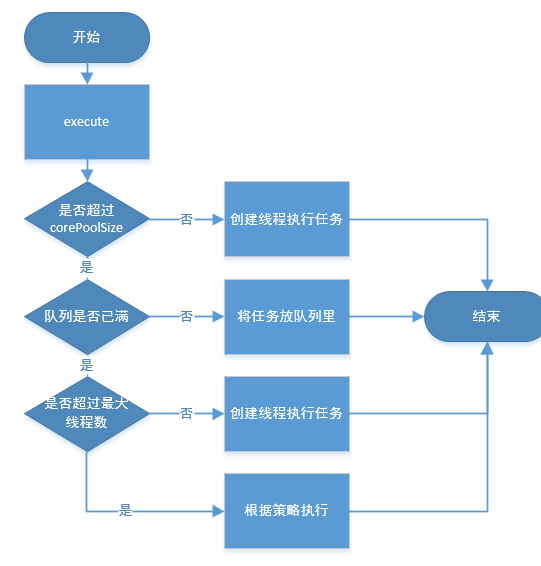java并发编程学习之线程池-ThreadPoolExecutor(三)
ThreadPoolExecutor
ThreadPoolExecutor是所有线程池实现的父类,我们先看看构造函数
构造参数
- corePoolSize:线程核心数
- maximumPoolSize:最大线程数
- keepAliveTime:线程空闲后,存活的时间,只有线程数大于corePoolSize的时候生效
- unit:存活时间的单位
- workQueue:任务的阻塞队列
- threadFactory:创建线程的工程,给线程起名字
- handler:当线程池满了,选择新加入的任务应该使用什么策略,比如抛异常、丢弃当前任务、丢弃阻塞队列的最老任务等,也可以自定义。
流程
- 判断是否超过线程核心数corePoolSize,没超过创建线程
- 超过线程核心数,则判断队列是否已满,没有满,放入队列
- 队列也满了,判断是否超过maximumPoolSize,没有就创建线程
- 超过了,根据策略执行

源码解析
//32为,前3位作为线程池的状态,后三位是线程数
private final AtomicInteger ctl = new AtomicInteger(ctlOf(RUNNING, 0));
private static final int COUNT_BITS = Integer.SIZE - 3;//28
private static final int CAPACITY = (1 << COUNT_BITS) - 1;00011111 11111111 11111111 11111110
//-1的二进制是11111111 11111111 11111111 11111111
private static final int RUNNING = -1 << COUNT_BITS;//-1如上,左移28位后,就是111000000 00000000 00000000 00000000
private static final int SHUTDOWN = 0 << COUNT_BITS;//0左移28位,还是0,00000000 00000000 00000000 00000000
private static final int STOP = 1 << COUNT_BITS;//00100000 00000000 00000000 00000000
private static final int TIDYING = 2 << COUNT_BITS;//01000000 00000000 00000000 00000000
private static final int TERMINATED = 3 << COUNT_BITS;//01100000 00000000 00000000 00000000
private static int runStateOf(int c) { return c & ~CAPACITY; }//~CAPACITY为11100000000000000000000000000000,与完就是线程的状态
private static int workerCountOf(int c) { return c & CAPACITY; }//与完,是线程的数量
private static int ctlOf(int rs, int wc) { return rs | wc; }
private static boolean isRunning(int c) {
return c < SHUTDOWN;//小于0,说明是RUNNING,RUNNING=-1
}
execute方法
public void execute(Runnable command) {
if (command == null)
throw new NullPointerException();
int c = ctl.get();
if (workerCountOf(c) < corePoolSize) {//如果线程数少于线程核心数
if (addWorker(command, true))//增加任务成功,返回true,没成功,继续往下
return;
c = ctl.get();
}
//判断队列
if (isRunning(c) && workQueue.offer(command)) {//如果线程池还在跑,并且可以插入队列
int recheck = ctl.get();
if (! isRunning(recheck) && remove(command))//线程池不是运行状态,就移除刚刚插入的任务
reject(command);//执行策略
else if (workerCountOf(recheck) == 0)//
addWorker(null, false);
}
//队列也满了,判断最大线程数
else if (!addWorker(command, false))
reject(command);//执行策略
}
addWorker方法
private boolean addWorker(Runnable firstTask, boolean core) {//core为true,使用corePoolSize判断,否则使用maximumPoolSize
retry:
for (;;) {
int c = ctl.get();
int rs = runStateOf(c);//获取当前线程状态
// Check if queue empty only if necessary.
if (rs >= SHUTDOWN && // 就是STOP、TIDYING、TERMINATED,此时不让任务进来
! (rs == SHUTDOWN &&
firstTask == null &&
! workQueue.isEmpty()))//
return false;
for (;;) {
int wc = workerCountOf(c);
if (wc >= CAPACITY ||
wc >= (core ? corePoolSize : maximumPoolSize))
return false;//超过了线程核心数或最大线程数,不让新增
if (compareAndIncrementWorkerCount(c))//返回true,说明成功了,跳出retry循环
break retry;
//失败了,说明被其他符号条件的线程占了,就再判断线程状态是否跟之前一样,不一样重新获取,跳到retry
c = ctl.get(); // Re-read ctl
if (runStateOf(c) != rs)
continue retry;
// else CAS failed due to workerCount change; retry inner loop
}
}
boolean workerStarted = false;
boolean workerAdded = false;
Worker w = null;
try {
w = new Worker(firstTask);
final Thread t = w.thread;
if (t != null) {
final ReentrantLock mainLock = this.mainLock;
mainLock.lock();//获取锁
try {
int rs = runStateOf(ctl.get());//获取线程池的状态
if (rs < SHUTDOWN ||
(rs == SHUTDOWN && firstTask == null)) {
if (t.isAlive()) // 没通过start来启动run的
throw new IllegalThreadStateException();
workers.add(w);//加点hashset
int s = workers.size();
if (s > largestPoolSize)
largestPoolSize = s;//更新当前最大值
workerAdded = true;//增加成功
}
} finally {
mainLock.unlock();
}
if (workerAdded) {
t.start();//启动线程
workerStarted = true;//启动成功
}
}
} finally {
if (! workerStarted)
addWorkerFailed(w);//失败,线程数-1,从hashset移除,并尝试Terminate
}
return workerStarted;
}
runWorker方法
上面执行 t.start();的时候,就会通过run方法调用下面的方法
final void runWorker(Worker w) {
Thread wt = Thread.currentThread();
Runnable task = w.firstTask;
w.firstTask = null;
w.unlock(); // allow interrupts
boolean completedAbruptly = true;
try {
while (task != null || (task = getTask()) != null) {//任务不为空或者获取的任务也不为空
w.lock();
if ((runStateAtLeast(ctl.get(), STOP) ||
(Thread.interrupted() &&
runStateAtLeast(ctl.get(), STOP))) &&
!wt.isInterrupted())
wt.interrupt();
try {
beforeExecute(wt, task);
Throwable thrown = null;
try {
task.run();//调用run方法,这里没有通过start,也就是说没有启动新线程
} catch (RuntimeException x) {
thrown = x; throw x;
} catch (Error x) {
thrown = x; throw x;
} catch (Throwable x) {
thrown = x; throw new Error(x);
} finally {
afterExecute(task, thrown);
}
} finally {
task = null;
w.completedTasks++;//完成任务数加1
w.unlock();//释放
}
}
completedAbruptly = false;
} finally {
processWorkerExit(w, completedAbruptly);//移除w,在task为空的时候,比如线程池状态停止或者启动的线程太多
}
}
getTask方法
当Worker第一次启动的时候,调用run方法,后面就一直从队列里获取任务
private Runnable getTask() {
boolean timedOut = false; // Did the last poll() time out?
for (;;) {
int c = ctl.get();
int rs = runStateOf(c);//获取当前线程池状态
// Check if queue empty only if necessary.
if (rs >= SHUTDOWN && (rs >= STOP || workQueue.isEmpty())) {//
decrementWorkerCount();//线程数量-1
return null;
}
int wc = workerCountOf(c);//线程数
//allowCoreThreadTimeOut为true,说明线程数要根据是否超过核心线程数判断keepAliveTime
boolean timed = allowCoreThreadTimeOut || wc > corePoolSize;//是否超过核心线程数
if ((wc > maximumPoolSize || (timed && timedOut))//超过了最大线程数
&& (wc > 1 || workQueue.isEmpty())) {
if (compareAndDecrementWorkerCount(c))//线程数-1
return null;//返回空
continue;
}
try {
Runnable r = timed ?
workQueue.poll(keepAliveTime, TimeUnit.NANOSECONDS) :
workQueue.take();//获取任务
if (r != null)
return r;
timedOut = true;
} catch (InterruptedException retry) {
timedOut = false;
}
}
}
正文到此结束
热门推荐
相关文章
Loading...











![[HBLOG]公众号](https://www.liuhaihua.cn/img/qrcode_gzh.jpg)

